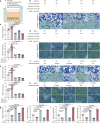The estrogen response in fibroblasts promotes ovarian metastases of gastric cancer
- PMID: 39349474
- PMCID: PMC11443007
- DOI: 10.1038/s41467-024-52615-9
The estrogen response in fibroblasts promotes ovarian metastases of gastric cancer
Abstract
Younger premenopausal women are more prone to developing ovarian metastases (OM) of gastric cancer (GC) than metastases of other organs; however, the molecular mechanisms remain unclear. Here we perform single-cell RNA sequencing on 45 tumor samples from 18 GC patients with OM. Interestingly, fibroblasts in OM of GC express high levels of estrogen receptor (ER) and midkine (MDK), interacting with tumor cells through activating ER-MDK-LRP1 (low-density lipoprotein receptor-related protein 1) signaling axis. Functional experiments demonstrate that estrogen stimulation induces MDK secretion by ovarian fibroblasts, and binding of MDK to LRP1 increases GC cell migration and invasion. Furthermore, in vivo, estrogen stimulation remarkably augments ovarian engraftment and metastasis of LRP1+ GC cells. Collectively, our findings reveal that ER+ ovarian fibroblasts secrete MDK under estrogen influence, driving OM of GC via the MDK-LRP1 axis. Our study holds the potential to catalyze innovative therapeutic strategies aimed at intercepting and managing OM in GC.
© 2024. The Author(s).
Conflict of interest statement
The authors declare no competing interests.
Figures







References
-
- Sung, H. et al. Global cancer statistics 2020: Globocan estimates of incidence and mortality worldwide for 36 cancers in 185 countries. CA Cancer J. Clin.71, 209–249 (2021). - PubMed
-
- Namikawa, T. et al. Frequency and therapeutic strategy for patients with ovarian metastasis from gastric cancer. Langenbecks Arch. Surg.407, 2301–2308 (2022). - PubMed
-
- Al-Agha, O. M. & Nicastri, A. D. An in-depth look at Krukenberg tumor: an overview. Arch. Pathol. Lab Med130, 1725–1730 (2006). - PubMed
Publication types
MeSH terms
Substances
Associated data
- Actions
- Actions
Grants and funding
LinkOut - more resources
Full Text Sources
Medical
Research Materials
Miscellaneous

